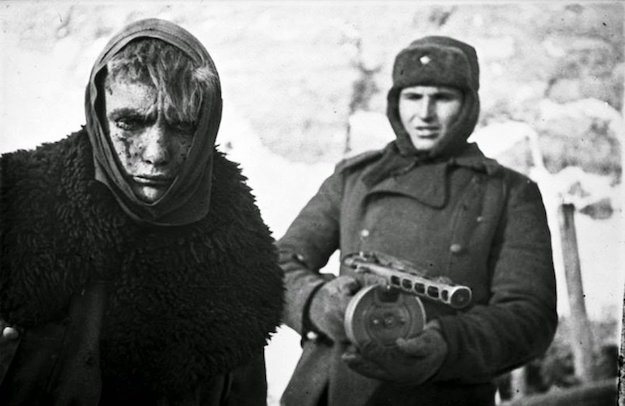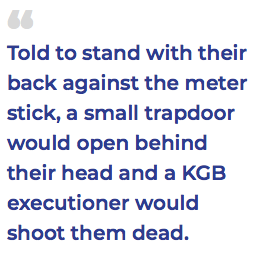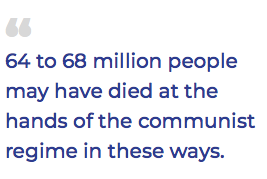The entire history of communism in the 20th century reeked of mass murder.

Once again… history – and the lessons it provides, but then Ocasio-Cortez probably cannot read without having an orgasm of sorts. ~ Ed.
In August of 1993, I was invited to participate in a conference in Vilnius, Lithuania on “Liberty and Private Business.” This was less than two years after the formal disappearance of the Soviet Union as a political entity on the map of the world.
During our time there, my wife and I were offered the opportunity to be given a tour of the building that had served as the headquarters of the local KGB, the infamous Soviet secret police. Our guide was a man who had been a prisoner in its walls in the late 1950s. The most nightmarish part of the tour was the basement containing the prison cells and the interrogation rooms.
Going Through Hell at the Hands of the KGB
As we reached the bottom of the staircase, our guide pointed to a small closet-like space and said, “Here was the first stop on the victim’s journey to hell.” The prisoner would be stripped naked and placed in this windowless, pitch-black closet for several hours. This was the start of the psychological torture. Left naked in absolute darkness for hours, the victim could only have the most frightening imaginings about why he or she had been arrested, what might be done to them, and whether they would ever see their family and friends again.
 Finally, they would be taken out and brought to a nearby interrogation room. The KGB interrogators asked him or her why they were an “enemy of the people” and what acts of espionage or sabotage or dissent they had committed. Who were their accomplices, and what were their names? The interrogators would insist that the prisoner sign a confession, usually already prepared for his or her signature, specifying their “crimes” against “the people” and the Communist Party. They just needed the names of his or her co-conspirators.
Finally, they would be taken out and brought to a nearby interrogation room. The KGB interrogators asked him or her why they were an “enemy of the people” and what acts of espionage or sabotage or dissent they had committed. Who were their accomplices, and what were their names? The interrogators would insist that the prisoner sign a confession, usually already prepared for his or her signature, specifying their “crimes” against “the people” and the Communist Party. They just needed the names of his or her co-conspirators.
There had been active opponents among the Lithuanian population after the retreat of the Germans and the return of the Soviet Army and communist control in 1944-1945 at the end of the Second World War. Some Lithuanians fought a guerilla war in the forests against the Soviet military well into the early 1950s. After all, Lithuania had lost its national independence as a result of the Nazi-Soviet Pact of August 1939, which turned over all three of the Baltic Republics – Estonia, Latvia, and Lithuania –to the tender care of the Soviet dictator, Josef Stalin. And the Lithuanians had wanted to be a free nation again. (See my article, “How Lithuania Helped Take Down the Soviet Union”).
But, in reality, virtually all of those arrested and interrogated had committed no “crimes against the State,” other than being on the wrong end of the accusations of others, who were, themselves, either informers or who had given names under similar interrogation. Perversely, a claim of innocence by a prisoner was taken as proof that they were obviously hiding something. And, besides, it did not matter if the person was innocent or not; the KGB higher authorities expected “results” in the form of confessions and names to pass on to their superiors in Moscow. So the interrogators had to have them.
The next stage of the process, if the confession was not forthcoming, was the use of physical torture in various excruciating forms until the prisoner met the interrogators’ demands. As further pressure, family members would be threatened with arrest and with being tortured or even killed right before the prisoner’s eyes if they did not confess. It might take days or even weeks, but most of those brought to that KGB basement eventually broke.
They would then be told that they would be transferred to another prison. Some were, often to a forced labor camp. But many would be taken to another room in the basement, on one wall of which was a meter stick. They would be told that they would be given a physical examination before being moved. Told to stand with their back against the meter stick to measure their height, a small trapdoor would open behind their head and a KGB executioner would shoot them dead.
Their lifeless body would be carried to another room where they would be placed on a steel table and any gold fillings would be removed from their teeth. Their bodies would be carried out of the basement through a back door and placed into a truck to be buried in a nameless mass grave with others who went through the same conveyor belt of KGB horror.
 Just three weeks earlier, my wife and I had been in Austria and had visited the Nazi concentration camp at Mauthausen near the city of Linz. What struck us after our tour of the KGB headquarters in Vilnius, Lithuania was just how similar the Nazi and Soviet methods had been. Indeed, in Mauthausen were the same steps and stages of arrest, psychological terror, interrogation and torture, murder through a trapdoor behind a meter stick, and the removal of gold fillings. The only difference between the German National Socialist and the Soviet communist techniques was that the Nazis threw the dead bodies into ovens to reduce them to ash and bone chips before disposal. The Soviets simply discarded the bodies in mass graves.
Just three weeks earlier, my wife and I had been in Austria and had visited the Nazi concentration camp at Mauthausen near the city of Linz. What struck us after our tour of the KGB headquarters in Vilnius, Lithuania was just how similar the Nazi and Soviet methods had been. Indeed, in Mauthausen were the same steps and stages of arrest, psychological terror, interrogation and torture, murder through a trapdoor behind a meter stick, and the removal of gold fillings. The only difference between the German National Socialist and the Soviet communist techniques was that the Nazis threw the dead bodies into ovens to reduce them to ash and bone chips before disposal. The Soviets simply discarded the bodies in mass graves.
Tyranny, Terror, and Torture
The entire history of communism in the 20th century reeked of mass murder. Not one country that followed the Soviet revolutionary model in the hundred years after the Bolshevik Revolution in November 1917 practiced anything noticeably different in form or content.
The noted Russian mathematician and Soviet-era dissident, Igor Shafarevich, who died on February 19, 2017 at the age of 93, ended his 1975 book, The Socialist Phenomenon, with the following conclusion and indictment:
“Most socialist doctrines and movements are literally saturated with the mood of death, catastrophe and destruction . . . One could regard the death of mankind as the final result to which the development of socialism leads.”
Is this too extreme a statement? Perhaps not, given that learned historians of the communist experience in the twentieth century had estimated that in the name of building the bright, beautiful socialist society of the future as many as 150 million to possibly 200 million unarmed, innocent men, women and children were shot, tortured, starved, or worked to death in labor camps as “enemies of the people.” (See my article, “The Human Cost of Socialism in Power”)
Estimates suggest that as many as 64 to 68 million people may have died at the hands of the communist regime in these ways during the nearly 75 years of the Soviet Union. Others have suggested that as many as 80 million of such innocent people may have been killed, again, from starvation, torture, labor camp work or execution in China from 1949 when the communist regime came to power to 1976 when Mao Zedong died.
Written by Richard M. Ebeling for the Foundation for Economic Education ~ March 09, 2017

 FAIR USE NOTICE:
FAIR USE NOTICE: